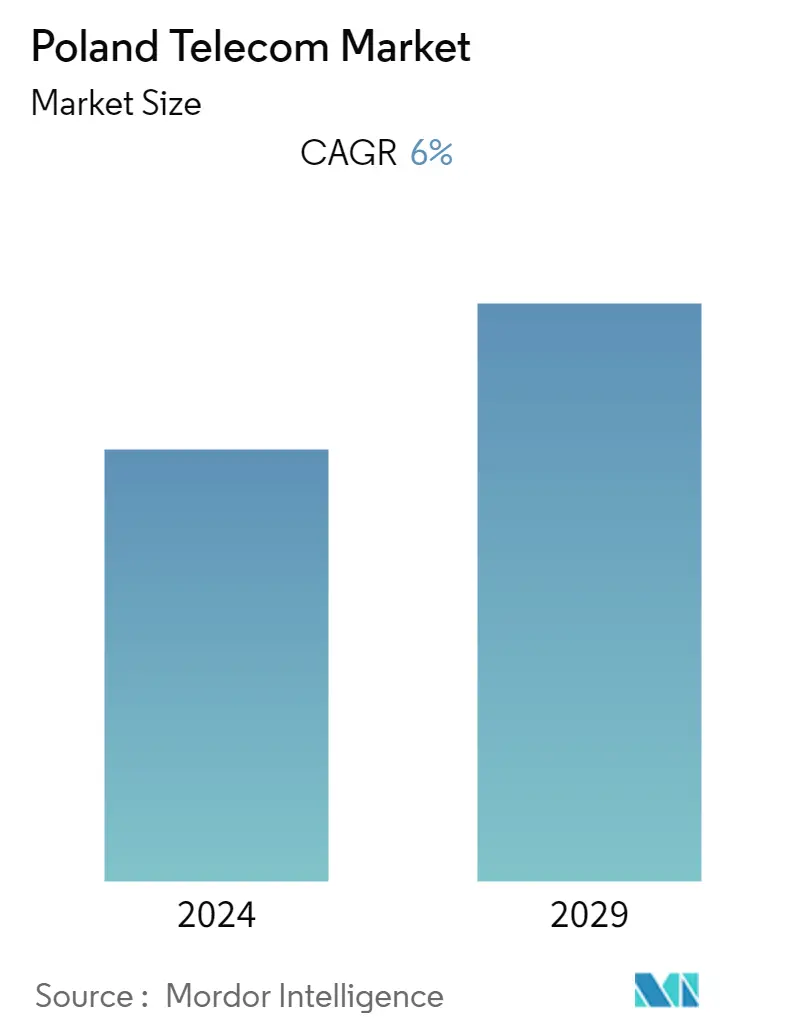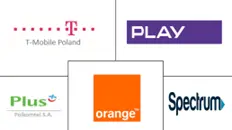Market Size of Poland Telecom Industry

| Study Period | 2019 - 2029 |
| Base Year For Estimation | 2023 |
| Forecast Data Period | 2024 - 2029 |
| Historical Data Period | 2019 - 2022 |
| CAGR | 6.00 % |
| Market Concentration | Low |
Major Players
*Disclaimer: Major Players sorted in no particular order |
Poland Telecom Market Analysis
The Poland telecom market is expected to register a CAGR above 6% over the next five years. The telecom industry in Poland is blessed with a robust local demand for telecom services. The market is well-positioned to meet the needs of expanding global connections between Asia and Europe. Poland's mobile market is supplied by an even distribution of mobile providers and MVNOs.
- The Polish mobile market is steadily expanding, with a total of 54 million mobile subscriptions. Strong 4G/LTE-A technology coverage ranges between 85% and 90% across carriers. The Office of Electronic Communication (UKE) stated that telecommunications investments amounted to PLN 8.9 billion (USD 1.96 billion) last year. 66.6% of fixed-line Internet users were already using connections with a minimum data rate of 100 Mbps. In addition, more people are using mobile connectivity with 4G technology. According to predictions, 81% of users with dedicated mobile Internet connections will reportedly be using 5G technology in 2026.
- According to Dataxis, the Polish pay TV market is very active and has well-established, bitter rivals vying for market share in the over-the-top (OTT) space. Operators are resorting to interactive TV to keep subscribers as the number of homes with cable and satellite access to TV is expected to decline in the coming years. Due to the plethora of local and foreign streaming services, the telecom industry is transitioning toward aggregation strategies. Although its user share of all TV services dropped to 49.5%, satellite access is still the most popular way to receive services.
- However, traditional fixed-line telephony is continuously declining in popularity. Last year, there were just a little more than 2.7 million customers. However, traditional fixed-line telephony is continuously declining in popularity. There were only slightly more than 2.7 million customers the previous year. VoIP is displacing traditional telephone services, and in terms of subscribers, it made up over 49% of all voice services provided on fixed networks last year. The increasing trend has continued in the mobile telecommunications sector, where there are currently over 56 million SIM cards in use and M2M card usage has increased.
- According to UKE, there has been a noticeable increase in the number (by around 30.000 during the previous year) of installed own telecommunications network nodes . In the previous year, the development of the telecom industry and the effectiveness of investments made with public money also contributed to the 4% increase in optical networks. At the end of the previous year, the Polish optical network had a total length of 421,000 km. The extension of the infrastructure would also increase the coverage and reach of the NGA networks. Over 80% of residences in Los Angeles will have fixed-line Internet with a speed of at least 30 Mbps.
- The need for quick mobile connections in Poland increased because of COVID-19. Following the pandemic, dedicated access utilising modems, cards, and keys increased significantly compared to 2019. When considering all available mobile access methods, Poland saw a significant increase in the number of people using mobile internet services per 100 people. Telecom providers' activities have expanded due to a rise in data traffic. Since the pandemic spread, the e-payment industry has experienced a major increase in activity. Teleconferencing and e-health have increased the demand for smartphones and digital services across the country.
Poland Telecom Industry Segmentation
Telecom or Telecommunication is the long-range transmission of information by electromagnetic means.
Poland Telecom Market includes in-depth trend analysis based on connectivity like Fixed Networks, Mobile Networks, and Telecom Towers. The telecom services are divided into Voice Services (Wired and Wireless), Data and Messaging Services, OTT, and PayTV Services. The adoption of telecom services is likely driven by several factors, including an increasing demand for 5G.
The market sizes and forecasts are provided in terms of value (USD million) for all the above segments.
| Segmentation by Services (Coverage to include Average Revenue Per User for the overall Services segment, Market size and Estimates for each segment for the period of 2020-2027 and in-depth Trend Analysis) | ||||
| ||||
| Data and Messaging Services (Coverage to include Internet & Handset Data packages, Package Discounts) | ||||
| OTT and PayTV Services |
Poland Telecom Market Size Summary
The Poland telecom market is experiencing significant growth, driven by a strong local demand for telecom services and its strategic position as a connector between Asia and Europe. The mobile sector is particularly vibrant, with a well-distributed network of mobile providers and MVNOs supporting a substantial number of mobile subscriptions. The market is characterized by robust 4G/LTE-A coverage, and there is a notable shift towards 5G technology, although the implementation of 5G is still pending due to regulatory developments. The fixed-line sector is witnessing a decline, with traditional telephony being replaced by VoIP services. The expansion of optical networks and the increase in telecommunications investments underscore the market's commitment to enhancing infrastructure and connectivity.
The Polish telecom industry is also seeing a transformation in the audio-visual sector, with a rise in over-the-top (OTT) services and digital content consumption. The pay TV market is competitive, with operators adopting aggregation strategies to retain subscribers amid the decline of cable and satellite TV access. The proliferation of streaming services like Netflix has significantly impacted the market, driving digitalization and changing consumer behavior. Cloud computing and digital transformation are gaining traction, with businesses and government organizations increasingly adopting these technologies. The market is fragmented, with major players like Orange Polska, Play Communications, and T-Mobile Polska leading the charge in innovation and infrastructure development, including high-speed internet services and drone operations.
Poland Telecom Market Size - Table of Contents
-
1. MARKET INSIGHTS
-
1.1 Market Overview
-
1.2 Industry Ecosystem Analysis
-
1.3 Industry Attractiveness-Porter's Five Force Analysis
-
1.3.1 Bargaining Power of Suppliers
-
1.3.2 Bargaining Power of Consumers
-
1.3.3 Threat of New Entrants
-
1.3.4 Threat of Substitute Products
-
1.3.5 Intensity of Competitive Rivalry
-
-
1.4 COVID-19 Impact on the Industry Ecosystem
-
1.5 Regulatory Landscape in the Country
-
-
2. MARKET SEGMENTATION
-
2.1 Segmentation by Services (Coverage to include Average Revenue Per User for the overall Services segment, Market size and Estimates for each segment for the period of 2020-2027 and in-depth Trend Analysis)
-
2.1.1 Voice Services
-
2.1.1.1 Wired
-
2.1.1.2 Wireless
-
-
2.1.2 Data and Messaging Services (Coverage to include Internet & Handset Data packages, Package Discounts)
-
2.1.3 OTT and PayTV Services
-
-
Poland Telecom Market Size FAQs
What is the current Poland Telecom Market size?
The Poland Telecom Market is projected to register a CAGR of 6% during the forecast period (2024-2029)
Who are the key players in Poland Telecom Market?
Orange Polska SA, Play Communications S.A, T-Mobile Polska S.A., Polkomtel Sp. z o.o. and Spectrum Poland are the major companies operating in the Poland Telecom Market.

